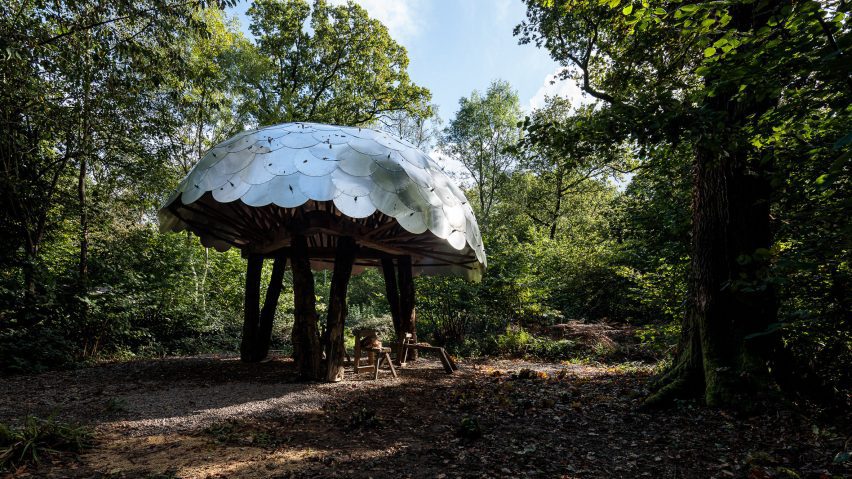British practices Invisible Studio and Pearce+ have created a woodworking shelter at Westonbirt arboretum in Gloucestershire with green oak framework and an aluminium shingle roof.
Designed for Forestry England as a companion to an existing community building, Invisible Studio and Pearce+ combined unprocessed timber construction methods and digital fabrication techniques to configure the hemispherical pavilion.
"We prototyped a way of supporting a roof on 'branches' with our students on a live build project and it worked really well," Invisible Studio founder Piers Taylor told Dezeen.
"We were interested to develop this as an idea for a woodland concept, designing a non-orthogonal space with a roof structure that had some of the delicacy of a tree."
The shelter's six-metre-diameter half-dome roof is supported on a network of six tree trunks connected to a triangular oak beam superstructure.
Above the main beams, a shell of watertight shingles was supported on 85 slim green timber poles.
According to the studios, the shelter was primarily designed to reflect the natural surrounds while remaining distinct through the rounded and overlapping metal canopy.
"The roof needed to be durable in a woodland context and create a space with high visibility for working and supervising groups," Taylor said.
In association with Lean Structures and computational designer Shahé Gregorian, the studios iterated the final fabrication techniques over a period of 10 months, seeking to establish a locally-responsive and sustainable precedent for building with drying timber.
"Any complex geometries are potentially costly and complex: the challenge here was making it affordable, and buildable in a woodland context," Taylor said.
"We wanted to use timber already felled on site as part of Westonbirt's management plan, so we picked all of these trees out and used them with minimal processing where possible."
The project was built by the design teams themselves through a mix of onsite manual assembly and limited off-site manufacturing, allowing them to adapt and problem-solve during the construction process.
"The A-frame was CNC machined in a workshop from a 3D plot to locate all the poles and countersink the ends, whereas all the poles were hewn by hand on site," Taylor explained.
"Locating all the 'points in space' on site for the centre of each shingle was challenging but fun... we enjoyed the sense that architects can expand their design role onto solving on site contingencies."
The woodworking shelter joins a series of community-focused interventions at Westonbirt arboretum, including a pair of maintenance buildings made from waste timber also designed by Invisible Studio.
Pearce+ are a UK-based multidisciplinary design studio that has previously been involved in the design of five accommodation pods on top of an arts centre in Watchet and an inflatable prototype shelter for two astronauts on a Bristol dockside.
Bath-based Invisible Studio was founded in 2010 by Piers Taylor and has completed projects including a rammed-earth yoga studio in Somerset and the renovation of an English cottage with a blackened timber extension. The studio has previously been shortlisted for emerging architecture studio of the year at the 2022 Dezeen Awards.
The photography is by David Butler

